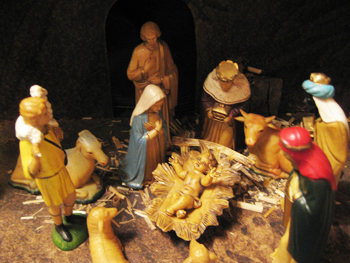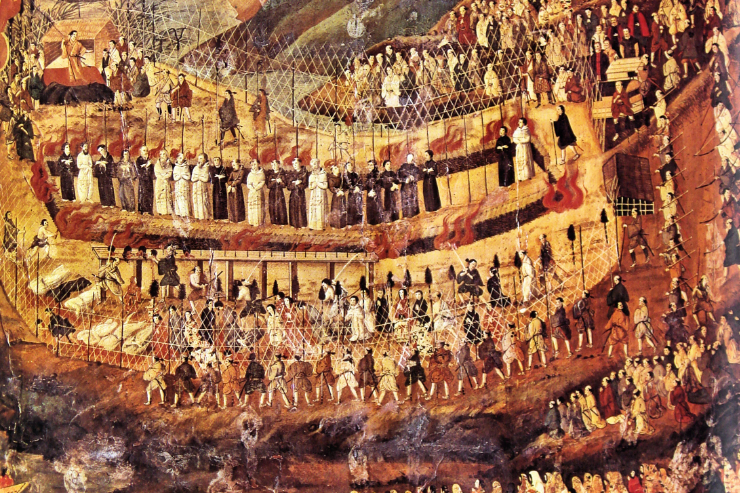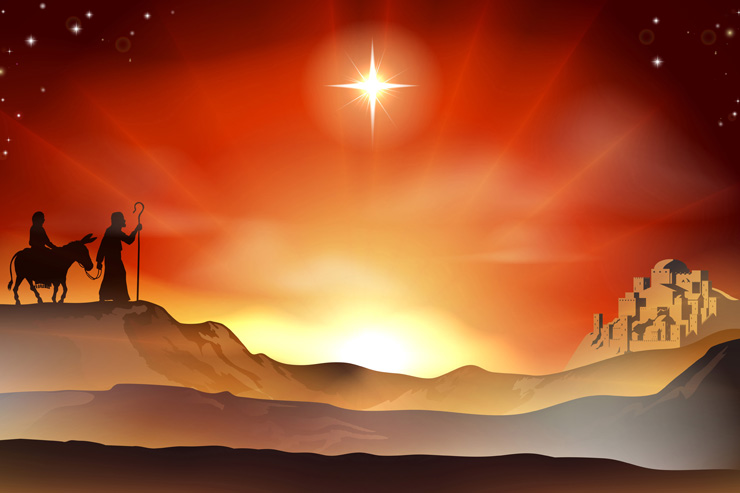
Crèche
In 1223, St. Francis of Assisi inaugurated a pious practice that in places today has become so common that many think that it always existed.
This great saint, as he was traversing the rolling hills of central Italy one December to proclaim the Gospel, noticed that few of his countrymen were taking the mysteries of the faith seriously. Many were not even preparing for Christmas at all. Of those who were preparing to celebrate the Lord’s birth, they looked at it as an event tied exclusively to the past. The mysteries of the faith had become sterile. The central persons in the drama had become stale and lifeless, incapable even of stimulating his contemporaries’ imaginations — and therefore no longer capable of inspiring them to a greater relationship of mutual love with God in the present.
To counteract these tendencies, on Christmas Eve 1223 in the town of Greccio, Francis set up the first crèche in recorded history. He brought in live animals — an ox and an ass. There was a young baby and a young set of parents. There was plenty of hay and a manger. There was even the attempt — with hundreds of burning torches — to create the luminescence of a bright star. And Francis could not have been happier with the results. People came from all over to see the living nativity. Through all the sounds, sights and even smells, the people became convinced that Christmas was not just a cute story, but a real event, one that was not just PAST, but something which they were called to enter in time. Soon living crèches like this spread throughout Italy. The phenomenon soon extended into art, as artists started to paint nativity scenes with all the main characters dressed anachronistically in 13th century garb — to emphasize that Christmas is not just a past event, but, even more importantly, a PRESENT one, in which every believer is called to “go now to Bethlehem” and “pay [Christ] homage.” As St. Francis’ first biographer wrote, “The Child Jesus had been forgotten in the hearts of many; but, by the working of his grace, he was brought to life again through his servant Francis and stamped upon their fervent memory.”
All the crèches in our homes, the beautiful praesepio here in Church, the Christmas pageant with our children after the 5:30 Vigil Mass — all of these have the same purpose, to “bring the child Jesus to life again” so that he may be “stamped upon our fervent memory.” Just as in St. Francis’ time, the “Child Jesus has been forgotten in the hearts of many.” Notice I said in the HEARTS of many, and not the MINDS. The minds of multitudes still recall details of Christ’s birth. Their memories are full of the words of Christmas hymns learned long ago. But their hearts are cold. Their reflection on Christ Jesus in Bethlehem does not ignite their hearts on fire with greater love for him.
That’s why this Christmas, one of OUR contemporaries — whom I believe future generations will regard as a great saint, much like we regard St. Francis today — is trying to do FOR US what the poverello from Assisi did for his generation. He wants to try to “bring the Child Jesus to life again.” The means he proposes does not involve animals, or hay, or our best attempts to emulate a shining star. They involve something far more basic, something that we can often take for granted and treat as lifeless as a plaster statue of the baby Jesus. To help the Child Jesus come to life in us, Pope John Paul II has called us all to live an intensely Eucharistic Christmas.
He wants us to see the connection between Christmas and the Mass, promising us that if we do, our appreciation for both will increase tremendously. The structure of the Mass is meant to recapitulate the entire life of Jesus, from his incarnation and birth, to his death and resurrection. Have you ever wondered why we sing “Glory to God in the highest and peace to his people on earth” at the beginning of every Sunday Mass (outside of penitential seasons)? When have we heard those words before? Those are the very words, of course, that the Angels used to announce the birth of Christ to the shepherds, which the Church proclaims at the Christmas Midnight Mass. At the beginning of every Mass, we’re called to reflect that the angels are announcing to us again “good news of great joy for all the people,” that Jesus, Emmanuel, is present. The same Jesus whom the shepherds went in haste to adore comes down on our altars through Christ’s own power working through his priests. The Gospel for Christmas Mass during the day climaxes with the expression, “ “The word took flesh and dwelled among us.” That of course is true for what happened 2000 years ago, but the Word-made-flesh continues to dwell among us in the Mass. In the Eucharist, Jesus remains God-with-us. Because of the Eucharist, the Church is the modern Bethlehem. The word Bethlehem means, in Hebrew, “house of bread,” and in each Mass Jesus, the “Living Bread come down from heaven” (Jn 6:51), comes down down from heaven for us. The Baby Jesus took on a body so that he could give that body for us. He was placed in a manger, a trough from which animals were accustomed to eat, and that could not have been more appropriate considering that that very body placed in that manger was intended for us, his creatures, one day to eat.
This connection between Christmas and the Eucharist is depicted very strongly in one of my favorite paintings, which is found in a tiny chapel in Providence, Rhode Island, where my priest confessor lives. Behind the tabernacle, there is a beautiful painting of the nativity, with Mary and Joseph, the Shepherds and the animals. But there’s one noticeable difference about this nativity scene. In the focal point of the whole painting, to which all of the adoring eyes point, there is not a manger or a painting of a child Jesus, but rather, there’s the TABERNACLE of the altar — the real one, not a painted image — where Jesus is truly substantially present. The effect is unforgettable. The same Son of God who was worshipped in the stable is worshipped there still. The only difference is that the veil of Christ’s divinity is no longer humble human flesh but the even humbler external appearances of bread and wine. Making that one change in Christ’s veil, we could sing about Jesus in the Eucharist what we chant about him in swaddling clothes:
Christ, by highest heav’n adored; Christ the everlasting Lord;
Late in time, behold him come, offspring of a virgin’s womb.
Veiled in [hosts] the Godhead see; Hail th’incarnate Deity,
Jesus, our Emmanuel, is pleased to dwell with us as one of us. But we know that not all of us are as pleased as he is. We recall that when Christ came into the world the first time, some people had room for him, some people did not. Mary and Joseph had room for him and gave their whole lives over to him and his mission. The Shepherds had room for him, left all their flocks behind and, in the middle of the night, ran to adore him. The Magi had room for him, and studied the heavens to discern a sign of his presence. When they discovered one in the star, they traveled for weeks, over hundreds of miles, to come to adore him, giving him the best gifts they had. But others did not have room for him. The inn-keepers had no room for their creator — or even to give shelter to a woman nine month’s pregnant. King Herod had no room for him, and in fact tried to have him killed. The scholars of the law had no room, not even enough curiosity to make the six mile journey from Jerusalem to Bethlehem to verify whether the wise men’s story was true. The vast majority of people in Jesus’ time, in Jesus’ land, simply did not accept him when he, the long-awaited Messiah, at last came. That’s why St. John will say in the Gospel for the Mass on Christmas day, “he came unto his own, but his own people did not receive him.”
In the Eucharist, we have a chance to get it right, or to get it wrong. Jesus in the Eucharist comes to his own, hoping that his own will receive him. We were made his own through baptism, much as the Jews were God’s own through circumcisions. The question is whether we’ll receive him with love, or whether we’ll — for one bad reason or another — not make room for him. I’ve always thought one of the reasons Jesus came as a baby is because we know from human experience that when we truly receive a baby, our whole lives change. Our sleeping patterns change. Our independence changes. Our bank accounts shrink. Our responsibility grows. If we truly receive Jesus, our sleeping patterns will change, as we’ll make time for prayer and make time for Mass. Our independence will change, as we become more dependent on him and allow others to become more dependent on us. Our bank accounts will shrink, as we start working more for him and for his kingdom and less for us. Our responsibility will grow, as we stop passing the buck for passing on the faith to others and ourselves become like those shepherds who returned from the encounter with Christ “glorifying and praising God.” Every year at Christmas Jesus comes to us almost as an orphan left on our doorstep and we either take him in, adopt him, allow him to grow with us and change us and our priorities, or we leave him outside. Jesus was born so that we might be reborn. The celebration each year of his birth is meant to lead us to a rebirth of faith.
Pope John Paul II teaches us that the way to enter most fully now into the mystery of Christ’s incarnation is through the Eucharist. He urges us to model our “Eucharistic amazement” on Mary’s Christmas awe. “Is not the enraptured gaze of Mary as she contemplated the face of the newborn Christ and cradled him in her arms that unparalleled model of love which should inspire us every time we receive Eucharistic communion?” Just as Mary’s life was centered on Christ Jesus and she made his mission her mission, so our lives are supposed to be centered on the same Christ Jesus, making him in the Eucharist the “source and summit” (Vatican II) of everything we do and are. If we would have journeyed on foot to Bethlehem 2000 years ago to adore Christ in the manger, the Pope is calling us to journey a short distance by car to adore him here. If we would have had room for him if he came knocking on our door, then we’re called to make room for him here, and make room for him every week, and if we can, every day. This is the way Christ will come alive again in our lives. This is the way he will be stamped upon our fervent memory. This is the way he will be remembered in our hearts.
Jesus is now knocking on the doors of our hearts with the hands of a little baby. As he said in the last book of the Bible: “Listen! I am standing at the door, knocking; if you hear my voice and open the door, I will come in to you and eat with you, and you with me.” As he fulfills those words literally in the Eucharist, we finish with the prayer Christians have lifted up for centuries:
O Holy Child of Bethlehem, descend to us we pray;
Cast out our sin and enter in, be born in us today.
We hear the Christmas angels the great glad tidings tell;
O come to us, abide with us, our Lord Emmanuel!
Please help us in our mission to assist readers to integrate their Catholic faith, family and work. Tell your family and friends about this article using both the Share and Recommend buttons below and via email. We value your comments and encourage you to leave your thoughts below. Thank you! – The Editors













